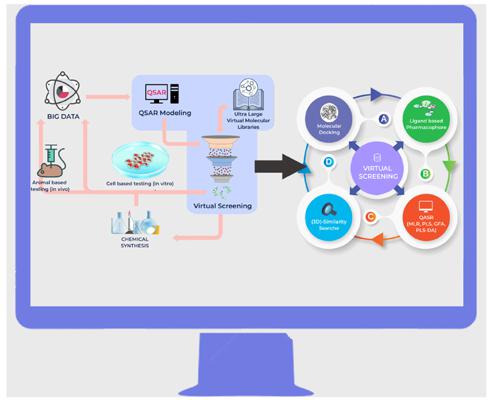Mini-Reviews in Medicinal Chemistry ( IF 3.8 ) Pub Date : 2020-07-31 , DOI: 10.2174/1389557520666200429102334 Patnala Ganga Raju Achary 1

|
The scientists, and the researchers around the globe generate tremendous amount of information everyday; for instance, so far more than 74 million molecules are registered in Chemical Abstract Services. According to a recent study, at present we have around 1060 molecules, which are classified as new drug-like molecules. The library of such molecules is now considered as ‘dark chemical space’ or ‘dark chemistry.’ Now, in order to explore such hidden molecules scientifically, a good number of live and updated databases (protein, cell, tissues, structure, drugs, etc.) are available today. The synchronization of the three different sciences: ‘genomics’, proteomics and ‘in-silico simulation’ will revolutionize the process of drug discovery. The screening of a sizable number of drugs like molecules is a challenge and it must be treated in an efficient manner. Virtual screening (VS) is an important computational tool in the drug discovery process; however, experimental verification of the drugs also equally important for the drug development process. The quantitative structure-activity relationship (QSAR) analysis is one of the machine learning technique, which is extensively used in VS techniques. QSAR is well-known for its high and fast throughput screening with a satisfactory hit rate. The QSAR model building involves (i) chemo-genomics data collection from a database or literature (ii) Calculation of right descriptors from molecular representation (iii) establishing a relationship (model) between biological activity and the selected descriptors (iv) application of QSAR model to predict the biological property for the molecules. All the hits obtained by the VS technique needs to be experimentally verified. The present mini-review highlights: the web-based machine learning tools, the role of QSAR in VS techniques, successful applications of QSAR based VS leading to the drug discovery and advantages and challenges of QSAR.
中文翻译:

基于定量构效关系(QSAR)的虚拟筛选在药物设计中的应用:综述。
全球的科学家和研究人员每天都会产生大量信息。例如,到目前为止,化学摘要服务中注册的分子超过7400万个。根据最近的一项研究,目前我们大约有1060个分子,被归类为新的类药物分子。这种分子的库现在被认为是“暗化学空间”或“暗化学”。现在,为了科学地探索这种隐藏的分子,当今有大量的实时和更新数据库(蛋白质,细胞,组织,结构,药物等)可用。“基因组学”,蛋白质组学和“计算机模拟”这三种不同科学的同步将彻底改变药物发现的过程。筛查大量类似分子的药物是一项挑战,必须以有效的方式进行治疗。虚拟筛选(VS)是药物发现过程中的重要计算工具;然而,药物的实验验证对于药物开发过程也同样重要。定量构效关系(QSAR)分析是机器学习技术之一,在VS技术中得到了广泛的应用。QSAR以其高且快速的通量筛选以及令人满意的命中率而闻名。QSAR模型的建立涉及(i)从数据库或文献中收集化学基因组学数据(ii)从分子表示中计算正确的描述符(iii)建立生物活性与所选描述符之间的关系(模型)(iv)QSAR的应用模型来预测分子的生物学特性。VS技术获得的所有命中都需要进行实验验证。本小型回顾重点介绍:基于Web的机器学习工具,QSAR在VS技术中的作用,基于QSAR的VS的成功应用导致药物发现以及QSAR的优势和挑战。


























 京公网安备 11010802027423号
京公网安备 11010802027423号